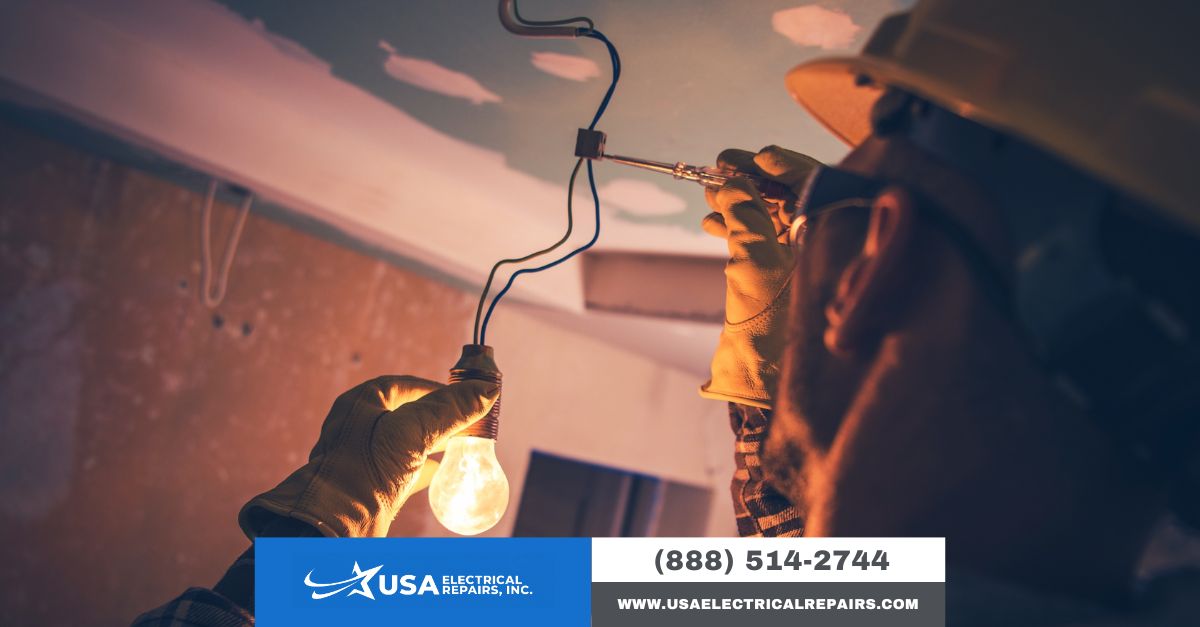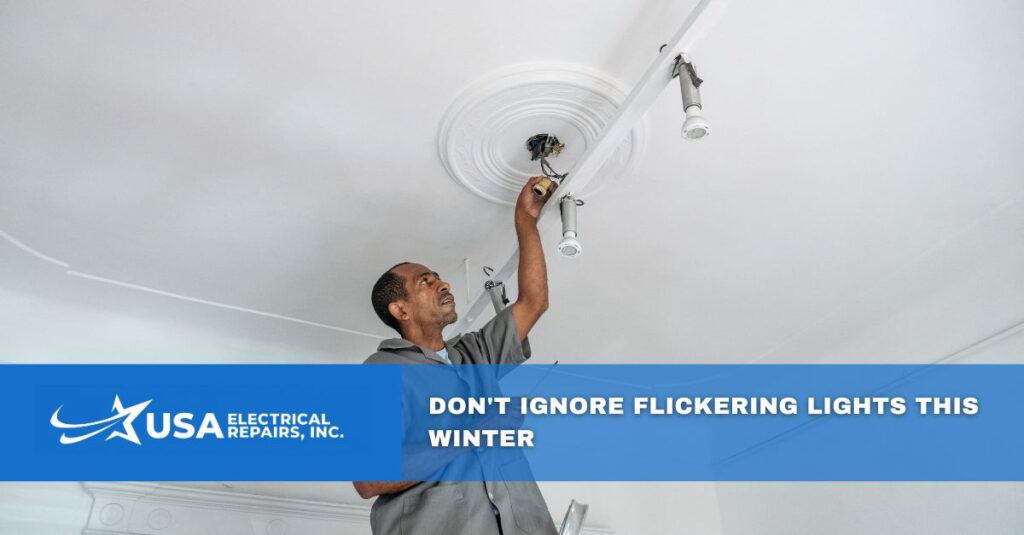As the days get shorter and the nights get colder, you’re likely spending more time indoors with the lights and heater on. While cozy, this increased demand on your electrical system can sometimes lead to noticeable issues, like flickering lights in house. Many homeowners brush this off as a minor annoyance, but it can often signal a more serious underlying problem.
Ignoring flickering lights, especially during winter when your electrical system is under greater strain, can pose significant risks to your home’s safety. This article will explain the common causes of flickering lights and why it’s crucial to address them promptly. Understanding these issues will help you protect your home and ensure your electrical system operates safely and efficiently all winter long.

What Causes Lights to Flicker?
Flickering lights in house can be caused by several electrical issues, ranging from simple to severe. While a single flickering bulb might just need tightening, consistent or widespread flickering throughout your home often points to deeper problems within your electrical wiring or panel.
Loose Wiring
One of the most common and dangerous causes of flickering lights is loose wiring. Over time, the connections in your outlets, switches, and electrical panel can become loose. When a wire isn’t securely connected, it can create an unstable electrical current, causing lights to flicker.
This intermittent connection can also generate excess heat, creating what is known as an “arcing” fault. Arcing is when electricity jumps across a gap in the connection, and it can heat up to several thousand degrees. This intense heat can easily melt wire insulation and ignite surrounding materials like wood or drywall, leading to a house fire. If you notice flickering lights in house when you plug in an appliance or flip a light switch, loose wiring could be the culprit. A qualified Los Angeles electrician can trace the source and secure the connection safely.
Overloaded Circuits
Winter brings an increased demand for electricity. You’re running the furnace, using space heaters, cooking more often, and turning on festive holiday lights. All this extra usage can easily overload your home’s electrical circuits.
An overloaded circuit occurs when you draw more power than the circuit is designed to handle. Your circuit breaker is designed to trip and shut off the power to prevent overheating, but before that happens, you might notice flickering or dimming lights. This is a clear warning sign that your circuit is under too much strain.
Consistently overloading your circuits can damage your electrical system and appliances over time. It can also weaken your circuit breakers, making them less effective at protecting your home. If flickering occurs when large appliances like a microwave or hair dryer turn on, it’s a strong indication of an overloaded circuit.
Moisture Issues
Winter weather can introduce another hazard to your electrical system: moisture. Rain, snow, and condensation can seep into your home’s exterior walls and come into contact with your electrical wiring. Water is an excellent conductor of electricity, and when it gets into junction boxes or service cables, it can cause short circuits.
These shorts can lead to flickering lights and, more alarmingly, create a serious risk of electrical shock and fire. The main service cable that runs from the utility pole to your house is particularly vulnerable. If the weather-head (the protective covering where the wires enter your home) is damaged, moisture can travel down the cable and into your main electrical panel, causing widespread corrosion and system failure.
Why Prompt Action is Crucial
The potential consequences of ignoring flickering lights are too serious to overlook. What seems like a minor inconvenience can quickly escalate into a major safety hazard.
- Fire Hazard: Loose wiring and overloaded circuits are leading causes of residential electrical fires. The heat generated from faulty connections can ignite nearby materials, leading to devastating damage.
- Appliance Damage: Unstable electrical currents can damage the sensitive electronics in your appliances, from your television to your refrigerator. Replacing these items can be costly and inconvenient.
- Electrical Shock: Moisture and damaged wiring create a direct path for electricity to travel where it shouldn’t, increasing the risk of electrical shock for you and your family.
Schedule a Professional Evaluation
If you’re experiencing flickering lights in your home this winter, don’t wait for the problem to get worse. The safest course of action is to have a professional electrician inspect your system. A trained expert can accurately diagnose the cause of the flickering, whether it’s a simple loose bulb or a more complex issue with your electrical panel.
Taking proactive steps ensures your home remains a safe and comfortable sanctuary during the colder months. A comprehensive evaluation provides peace of mind and protects your home from the hidden dangers of a faulty electrical system.
Trust the Experts at USA Electrical Repairs
Don’t let flickering lights cast a shadow over your winter. Protect your home and family by addressing electrical issues with the help of a trusted professional. The team at USA Electrical Repairs, Inc. is here to ensure your electrical system is safe and reliable.
Call us today at 888-514-2744 to schedule your comprehensive electrical panel evaluation. Our experienced electricians will provide honest assessments and transparent pricing to help you make the best decision for your home and budget. You can also browse our website for more information about our electrical installation services and see how we’ve helped other Los Angeles homeowners solve their electrical challenges safely and effectively.

